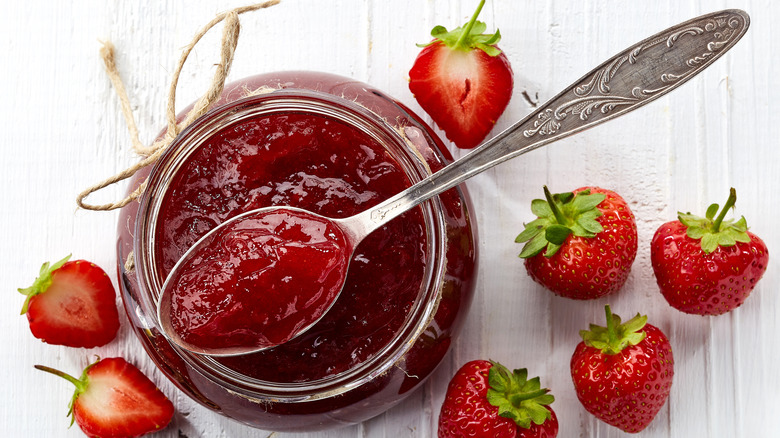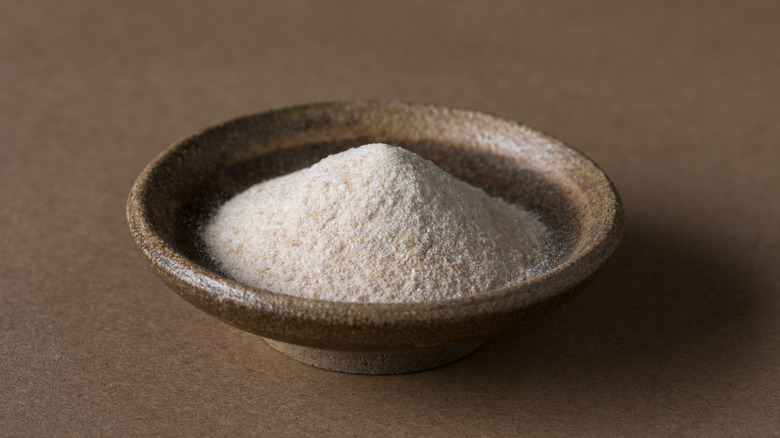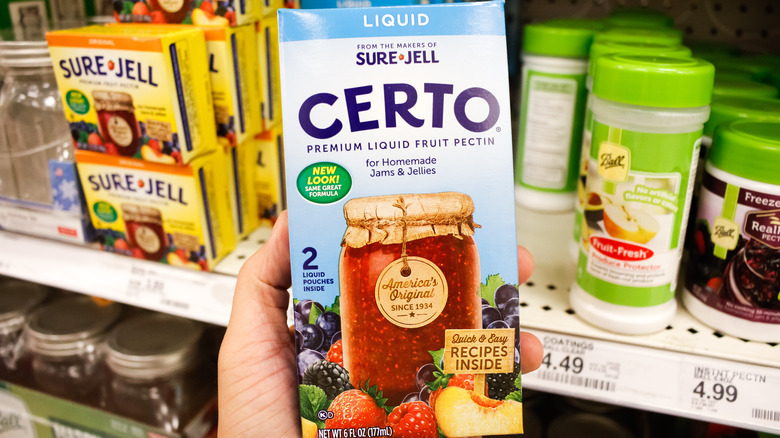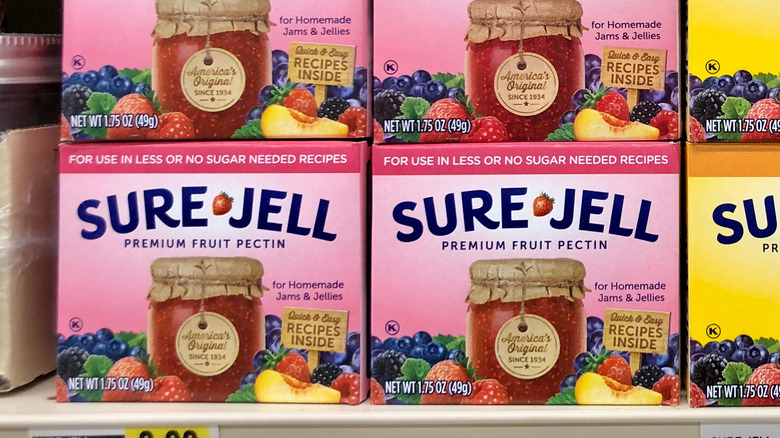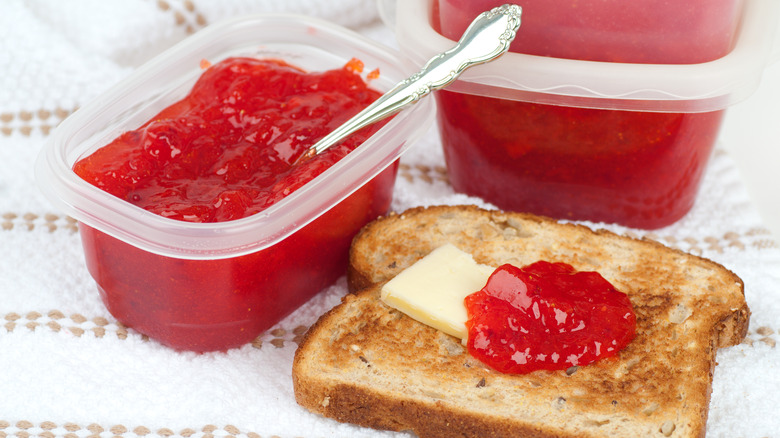Why The Different Types Of Pectin Matter In Home Canning
If you are staring down your first round of home canning while dreaming of homemade jams and jellies lining your shelves just waiting for a piece of warm toast, you are going to have to learn about pectin. Pectin is a type of fiber naturally found in plants that reacts with water to gel and hold cells together (via Popular Science). That binding action makes it useful in canning as it can be added to fruits with naturally low amounts of pectin, like blueberries, to help them firm and gel more, giving you that nice smooth, spreadable consistency instead of a runny mess.
There is a whole world of pectin out there, each with different properties that will affect when you add them and how your preserves set. The old-school, pre-industrial method was to toss some chunks of apple or other fruit in with your jam to boost the final consistency. You can still do that if you don't mind the added flavor, but there are also tons of naturally-derived commercially-produced pectin on the market (via Serious Eats). Choosing the right pectin for your canning project can be a matter of recipe or taste, so you're going to know what you're getting into with each type.
Powdered Pectin
The powdered variety is the most common pectin on store shelves. According to Preserve and Pickle, it is extracted from high-pectin foods like apples. The natural liquid is concentrated and dried to form the powder, which is more shelf stable. Then, powdered pectin is added to the fruit before you start cooking so that the heat and liquid from the fruit can further activate it.
Powdered pectin needs a little bit of help to wake up its natural gelling power. First of all, the water lost in the drying process needs to be added back in. You'll need to boil powdered pectin in a bit of water before adding it to your fruit puree (via The Kitchn). Powdered pectin also needs sugar added to get the right texture. Cutting back on sugar in a recipe can leave your jam more watery, and you don't want that special jam you labored over to run right off your cracker. So if you are trying to make a more fruit-forward, less sweet jam, powdered pectin might not be the right choice for you.
Liquid pectin
Liquid pectin is essentially just a hydrated version of powdered, avoiding the first step of boiling the powdered substance in water. The main advantage of liquid pectin over powder is the ease of use. There is no need to boil it first or cook it with fruit. You just add the liquid at the end of boiling your jam, and it will instantly start to set (via Food in Jars). You also lower the chance of clumping, which can sometimes be a problem with powder.
The disadvantage is that liquid is more expensive and it doesn't last as long on the shelf as the powdered version. You are essentially paying a premium for convenience (via Pick Your Own). Because both require the same amount of sugar and set in a similar way, so your choice between liquid and powdered is going to boil down to how much pectin you go through and if you think that simplicity is worth it. But it will make your strawberry jam that much easier.
Low-sugar pectin
Low-sugar pectin is a variation of traditional powder pectin, but it activates without the need to add sugar in most recipes. According to Serious Eats, because low-sugar pectin often contains a small amount of dextrose, it adds acid to your jam. This aids in the preservation process as well as lowering the amount of sugar needed to set. It does need some help from another acid like lemon juice to work; a requirement not seen in standard pectin.
This variety of pectin has the big advantage of allowing you to customize your preserves more by altering the levels of sugar you are using without sacrificing much in the way of texture or preservation. As Pick Your Own explains, you can even add artificial sweeteners or try different sources of sugar like fruit juice. With low-sugar pectin, whether it is health concerns or just your personal taste, you can get a tartier, fresher jam without loading up with added sweetness.
Instant pectin
Instant is another variety of powdered pectin. But instead of cutting out the sugar, this one eliminates the need to cook your fruit (via The Kitchn). This type of pectin is almost exclusively used in making freezer jam, which is stored cold because it is runnier and the bacteria that could cause spoilage has not been killed off by the heat from cooking. Just crush or puree your fruit, mix with instant pectin and sugar, and freeze.
Although it may just seem like a shortcut, freezer jams actually have some nice qualities that may make you prefer them to normal jam and jelly. According to NPR, freezer jam is going to taste a lot closer to the real fruit because the lack of cooking preserves the fresh flavor. Combine that with the fact you don't need to sterilize your jars with its long shelf life, you may opt for freezer jam over the traditional stuff for reasons beyond convenience.
Can you substitute different types of pectin for one another?
The short answer as to whether you can substitute one form of pectin for another is yes. The longer explanation is yes if you follow instructions and understand how different pectin sources may change the results. SB Canning notes that not only are the times that you add pectin going to change, but you may need more or less sugar, thus altering the recipe. It is also important to know how to convert the measurements of these different pectins as Pick Your Own suggests ½ cup of powder for every packet of liquid pectin.
Low-sugar or instant pectin are going to be better for when you really want to alter a recipe. Low sugar should act like normal powdered pectin but will obviously make your jam less sweet. Adding the same amount of sugar you would in the past could alter how firmly it sets (via Food Preserving). Instant pectin will save you time, but unless you use it to make anything other than freezer jam, you are not going to get a set spread. In the end, you should use your pectin knowledge and pick the right variety that is best for the kind of jam you like.
